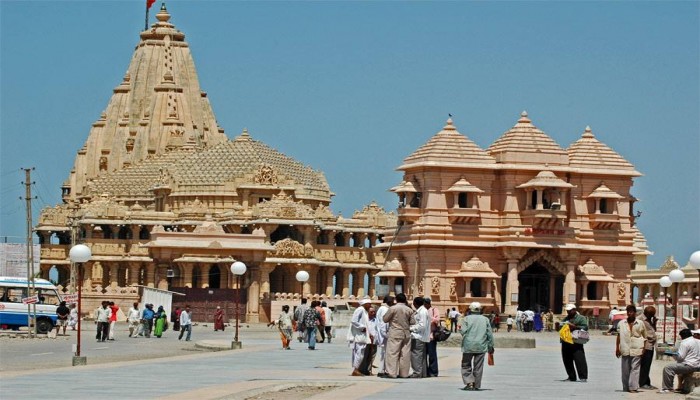Book Review of Sita Ram Goel’s Hindu Temples: What Happened to them?
- In Current Affairs
- 12:24 PM, Nov 17, 2018
- Ramaharitha Pusarla
Supreme Court, the highest judicial authority of India has yet again postponed hearing the Ramjanambhoomi Mandir (RJM) issue. The case has been languishing under the ambit of the SC for more than seven years now. This time again, citing, “we have our own priorities” and calling for instituting an appropriate bench for daily hearings of the issue postponed it to January 2019. A section of society echoed SC’s views and questioned the urgency of resolving nearly 500-year old dispute. Others believed that RJM issue would cede undue political mileage to parties’ adept in milking the religious and cultural sentiments of people before crucial assembly elections in five states. But invariably, SC’s postponement tactics appeared to be in line with the arguments of Kapil Sibal, advocate of Sunni Wakf Board who vociferously argued scheduling the hearing the RJM case to after 2019 elections.
While the momentum of the temple issue began to gain ground, to educate myself about Hindu temples, I laid my hands on the highly recommended two-volume series on Hindu Temples by Indian Historian Sita Ram Goel. Vol-1: Hindu Temples What Happened to them: A Preliminary Survey and Vol-2: Hindu Temples What happened to them: The Islamic Evidence. These books are considered as the most authoritative compilation of Hindu temples in the Indian sub-continent.
The first volume is compendium of articles written by various scholars- Ram Swarup, Harsh Narain, Abhas Kumar Chatterjee, BB Lal, Rizwan Salim, Koenraad Elst, Arun Shourie, and Alexander Cunningham. It contains a list of over 2000 Muslim monuments built over razed temples with the materials from Hindu temples. The second volume has an exhaustive list of foreign Muslim invasions, their relentless temple plunder, destruction and eventual demolition of temples. Comprising of extensive references from over 80 different treatises written by Muslim historians the second volume contains an authentic record of ruthless destruction of Hindu temples across India by various Muslim invaders.
Instead of succumbing to shallow intellectualism of issuing blanket statements based on random and select works, the author painstakingly collates available Persian sources to make authoritative and unbiased claims. Wavering from the tradition of seeking refuge in the pleasantries of appeasing the Muslim community in India Goel makes sharp observations pertaining to Islam theology. He trounces Islam apologetics for reinforcing that Islam is a religion of tolerance and peace and tears into the iconoclastic zeal of the Muslim invaders. For long the Marxists historians invented theories to portray Muslim rulers as benevolent messiahs and presented them as native rulers. But Goel unapologetically hits back at the leftist historians by questioning their intentions in deliberately falsifying, distorting and diligently omitting instances that oozed the fervent Islamic iconoclasm. In a bid to glorify Muslim invaders they gave clean chit to the Muslim theology. Though concocted theories, Indians were made to believe that Muslim rulers plundered temples out of greed and lust for treasure. Stating that temples repositories of precious metals, gems, jewellery, semi-precious stones became targets for plunder and loot. They argued that Muslim rulers attacked temples to maintain their armies and for administrative purposes. Further they justified all such destructions claiming that temples being cultural and religious hubs of Hindus also acted as centres of rebellion. It became inevitable for the rulers to destroy such places to quell insurgencies. But never mentioned that mosques, idgahs, dargahs, mazaras, maqbaras, madrasas and monuments were built over the rubbles of destroyed temples. Baring the Jama Masjids majority of the Muslim structures were built over bulldozed Hindu temples. The remnants of destroyed temples are often laid at the footsteps of Jami Masjids so that “believer” could trample over Kafirs idols to ascertain their supremacy. These Masjids are built from the remains of Hindu temples.
Exonerating Muslim rulers of iconoclasm, historians meticulously asserted that historical mosques replaced the pre-existing Hindu temples without bothering to mention how such a sudden transition occurred. Top-notch Indian historians churned out stories of Hindu temples that subject years of neglect suffered damage and Muslim rulers eventually erected Muslim structures in their place. As a matter of fact, Hindu kings patronised temples and personally looked after the upkeep and maintenance of temples. They assigned vast acres of land for the purpose of smooth running of temples. For decades, none of the recklessly churned out specious theories of Marxist historians who dominated the academia remained unchallenged. Perhaps Sita Ram Goel’s books provide detailed account of epigraphic and historical evidence corroborating iconoclastic zeal of Muslims.
First volume contains a detailed account of the Hindu Temples converted or whose debris was used to build Muslim shrines/monuments across India since first Islamic invasion in 650 ACE till 18th century. Though the list is exhaustive, it is not complete and is first of its kind. The author believes that it is just tip of iceberg and appeals young historians to compile a record of Muslim iconoclasm. Fresh excavations from Archaeological Survey of India of some of the historical sites, seats of Muslim occupation are now uncovering new details. But none of the reputed Indian historians ever questioned the foundations of mass plunder of Hindu temples and the Islamic theology which inspired the swordsmen to kill thousands of people, capture the booty, raze temples, convert people enmasse into Islam and sell Hindus as slaves. While the Muslim histories took pride in the iconoclastic zeal of Muslims invaders and frequently cited the Quran and Sunnah to support despicable violence unleashed on Hindus, Indian historians refrained from speaking Muslim theology.
The book contains the iconic exchange of letters between Syed Shahabuddin pioneer of All India Babri Masjid Action Committee (AIBMAC) who challenged intellectuals to contest Muslims claim over the Ramajanmabhoomi. In response to the pamphlets issued by JNU and other historians, Dr Harsh Narain and Abhas Kumar Chatterjee, a civil servant published rebuttals in Indian Express. The lively debate through letters is worth a read since it exposes the nexus between the Islamic imperialists who employed leftist historians to peddle lies. Interestingly when the government called both parties, AIBMAC and VHP (Vishwa Hindu Parishad) to resolve the issue peacefully, AIBMAC in their defence produced a pile of newspaper references and vast literature of polemics. Their arguments were devoid of logic nor backed by hard facts. But the cabal managed to create pernicious doubts in the minds of Hindus through vicious propaganda on Hindu claims over the supremely important site. Above all it includes an article of Prof BB Lal who called the bluff of leftist historians who debunked archaeological evidences that indicated a 11th century Hindu temple beneath the Babri Mosque. Despite religious, historical, archaeological, mythological evidences establishing Ayodhya as birth place of Lord Rama, leftists continued to demand more evidence. An in depth understanding of Ramajanmabhoomi issue is pivotal for Hindus to reclaim temples. Besides, it reinforces the fact that leftist historians known for their hostility towards Hinduism will continue to defend the indefensible through fallacious and specious arguments. By changing goal posts, they will try to buy time and drag on the issue for eternity.
The scale of plunder, loot and destruction suffered by the Hindu temples especially those of great religious significance and prominence is just indescribable. Perhaps, this might be the reason why it is difficult to Indian references in old texts of this unspeakable trauma and brutality. While Persian historians paid rich tributes to the rulers who ordered such large-scale demolitions and hailing them as dearest one to Allah. Muslim histories have generous recordings of temple demolitions.
From among the 80 different sources quoted by Goel in Volume:2, the following is an account of the brutal attack on Somnath recorded in “Tarikhul-I-Hind” written by Abu Rihan Muhammad bin Ahmad al-Biruni al Khwarizmi who spent forty years in India. Documenting the expeditions of Sultan Mahmud of Ghazni (997-1030) to Somnath, he wrote “The linga he raised was the stone of Somnath, for soma means the moon and natha means master, so that the whole word means master of the moon. The image was destroyed by Prince Mahmud, may God be merciful to him! AH-416. He ordered the upper part to be broken and the remainder to be transported to his residence, Ghaznin, with all its coverings and trappings of gold, jewels and embroidered garments. Parts of it has been thrown into the hippodrome of the town, together with the Cakrasvamin, an idol of bronze, that had been brought from Taneshar. Another part of the idol from Somnath lies before the door of the mosque of Ghaznin, on which people rub their feet to clean them from dirt and wet”. Indeed, the second volume is replete of such iconoclastic expeditions of Muslim rulers. Forsaking the tradition of asking inconvenient questions, Goel at the end of the book encloses a questionnaire to Marxist historians to take up the challenge of contesting the contents of the book with evidence-based facts. Till now, historians deflected the tough questions posed to them by citing random instances of Hindu rulers destroying Buddhist and Jain monuments. Goel rebutted this orchestrated propaganda of drawing parity between the Islam rulers and the Shaivite Hindu rulers with solid evidences towards the end of the book. Designated special chapters to address various aspects of monotheistic religions, Goel provides evidences of how Islam wiped away the pagan culture of Arabs by destroying their idols and places of worship. The book talks about the Islamic theology of iconoclasm in depth and supports the narrative with literary evidences.
In volume 2 Goel launches unsparing attacks on the Leftist casuistry which is devoid of rigorous logic. He implores Hindus to understand the foundation of the Islam theology, an ideological guide for global Islamist movements. India bore the brunt of iconoclastic zealotry for thirteen centuries. Revivalist Islamist Movement paved way for partition of the country. After partition, Hindus have been living on the edge in Pakistan who were reduced from 25% of the population to barely 2-3% currently. Hindus in Bangladesh are facing similar threats. Decades after independence, Hindus were driven out of the Kashmir valley which has now turned into fertile breeding ground of radical Islam. Thriving Islamist movements are a formidable threat to security and sovereignty of India. After independence, despite suffering centuries of Muslim, European and Communist imperialism India failed to realise importance of unaltered history with fidelity of facts. It has allowed the communists masquerading as intellectuals to write Indian history. They imposed upon India a distorted, falsified and contorted version of history leading to deracination of Hindus. Educated urban elite divested of the basic understanding of Indic civilisation now hardly bother about the Hindu temples. No wonder this elite class of Hindus are the forefront gloating over the need for reclaiming centuries old Ramjanamasthan.
Disclaimer: The opinions expressed within this article are the personal opinions of the author. MyIndMakers is not responsible for the accuracy, completeness, suitability, or validity of any information on this article. All information is provided on an as-is basis. The information, facts or opinions appearing in the article do not reflect the views of MyindMakers and it does not assume any responsibility or liability for the same.







Comments